Healing Back Pain 2.0 ( Fix Back Pain in Lower Right): A New & Revolutionary Approach to Back Pain, Without Drugs or Expensive Therapy (Sonny Vale Book 4) by Vale Sonny

Author:Vale, Sonny [Vale, Sonny]
Language: eng
Format: epub, pdf
Publisher: Back Pain in Lower Right, Pub
Published: 2020-09-20T16:00:00+00:00
X-ray
X-rays are easy to do and can be very valuable in initial diagnosis. X-rays can show arthritic changes of the vertebrae, along with bony abnormalities or compression and other types of fractures. This is an important first step when someone is complaining of severe back pain, but because an X-ray only shows bones, you cannot clearly see the discs or the nerves. This means that, with an X-ray alone, you cannot always determine the cause of the pain.
MRIs are more costly and difficult to do. They differ from an X-ray in that they can show soft tissues such as discs, nerves, and muscles. This can provide additional information beyond what is shown in the X-ray and allow your medical team to make a more definitive diagnosis. With an MRI you can usually see if there is a disc bulge or herniation and whether or not the nerve is getting compressed as it exits the spine.
Do I need an MRI?
On the favorable side, MRIs provide the best way to see what is going on in your back. You can see the discs and nerves and how much a nerve may be compressed.
On the unfavorable side, MRIs often show problems that are unrelated to the current areas of pain. Patients can get sidetracked and even depressed by the findings.
Many times, people find that there is more deterioration than they were expecting. This can be disconcerting; however, it doesnât necessarily explain why the current problem exists.
As an example, anyone over the age of thirty should expect to see some signs of degeneration. The average person may experience no pain, yet still see signs of small to moderate disc bulges, degenerative diseases, etc. However, this may not be the exact cause of sciatica.
It is important to use the MRI as part of the exam and make sure it correlates to the clinical exam to determine the cause of your problems so you can treat the real issue while not getting sidetracked.
Generally speaking, a comprehensive clinical exam should be enough to begin treating your symptoms and place you on a home rehab program.
However, as we discussed previously, you should seek the advice of a physician if any of these red flags occur:
â â¢â Foot drop
â â¢â Saddle paresthesia
â â¢â Bilateral numbness and tingling
â â¢â Altered gait pattern
â â¢â Bowel or bladder incontinence
â â¢â Numbness in the saddle area (buttocks, groin, etc.)
â â¢â Localized swelling
â â¢â Pain, redness, or discoloration of the foot
â â¢â Significant night sweats
Download
Healing Back Pain 2.0 ( Fix Back Pain in Lower Right): A New & Revolutionary Approach to Back Pain, Without Drugs or Expensive Therapy (Sonny Vale Book 4) by Vale Sonny.pdf
This site does not store any files on its server. We only index and link to content provided by other sites. Please contact the content providers to delete copyright contents if any and email us, we'll remove relevant links or contents immediately.
The DNA Book by DK(777)
The Spike by Mark Humphries;(768)
The End of Food Allergy by Kari Nadeau MD PhD & Sloan Barnett(685)
Extra Life by Steven Johnson(666)
Your Brain Is Always Listening by Dr. Daniel G. Amen(651)
How to Sleep by Rafael Pelayo(600)
Unlocking Eden: Revolutionize Your Health, Maximize Your Immunity, Restore Your Vitality by Belt Daniel & Horn Joe(594)
The Hashimoto's AIP Cookbook: Easy Recipes for Thyroid Healing on the Paleo Autoimmune Protocol by Emily Kyle MS RDN CLT HCP & Phil Kyle Chef(591)
The Hospital by Brian Alexander(590)
The Low-FODMAP IBS Solution Plan and Cookbook by Rachel Pauls(582)
The Covid Survival Guide: What the Virus Is, How to Avoid It, How to Survive It by Rowell David(566)
The Big Book of Baby Names by Marissa Charles(553)
Lymph & Longevity by Gerald Lemole(539)
Linda Goodman's Love Signs by Linda Goodman(521)
Better Living Through Neurochemistry - A guide to the optimization of serotonin, dopamine and the neurotransmitters that color your world by James Lee(515)
Thrivers by Michele Borba Ed. D(508)
The Miracle Pill by Peter Walker(503)
Stroke For Dummies by John R. Marler(491)
Immunity by Jenna Macciochi(487)
